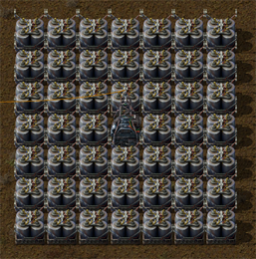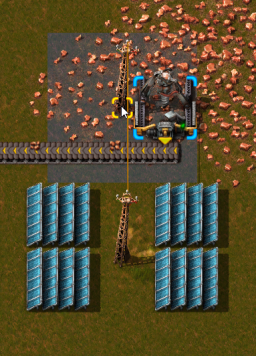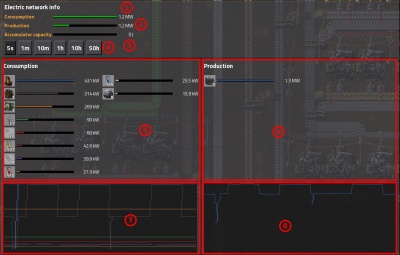Sieć elektryczna
PS This page is not finished! Ta strona nie jest jeszcze skończona!
Sieć elektryczna jest używana do zasilania wielu różnych urządzeń. Każde urządzenie ma własny magazyn energii. Gdy energia jest produkowana, zostaje ona równomiernie rozprowadzona do wszystkich odbiorców w sieci.
Elementy sieci
Generacja
Są cztery sposoby na wyprodukowanie energii. Więcej szczegółów na temat każdej metody można znaleźć na stronie Generacja energii.
- Silnik parowy - Najbardziej powszechny, wymaga Boilery (które zużywają Wodę oraz paliwo).
- Ogniwo słoneczne - Darmowa energia, lecz działająca wyłącznie za dnia. Często stosowana wraz z akumulatorami.
- Akumulator - Magazyn energii, zobacz poniżej
- Turbina parowa - Wydajniejsza wersja silników parowych. Używane do generacji prądu z użyciem Reaktora jądrowego.
Jeśli zużycie energii jest niższe od produkcji, Silniki parowe i Turbiny parowe zwalniają, więc energia nie jest marnowana..
Magazynowanie
Energia może być magazynowana w Akumulatorach. Akumulatory ładują się nadmiarem energii i rozładowują się gdy pobór przekracza normalną produkcje.
Dodadkowo, Para może być magazynowana w Zbiorniku, pozwalając Silnikom parowym oraz Turbinom parowym działać na żądanie. Ta technika jest powszechnie stosowana w układach z Reaktorem jądrowym w których same reaktory wytwarzają więcej mocy niż jest to konieczne i działają tylko sporadycznie.
Distribution
Power poles are used to transmit energy. There are 4 types of power pole, each having differently configured properties. The properties are coverage area (area in which machines are placed to be affected by the pole) and wire reach (the distance across which a pole can connect with another pole). If two poles of different wire reach are to be connected, the smallest of either applies.
- Small electric pole - Second smallest coverage area, shortest cable length, available without research.
- Medium electric pole - Second largest coverage area, average cable length.
- Big electric pole - Smallest coverage area, longest cable length.
- Substation - Largest coverage area, second longest cable length, but most expensive to build.
Consumption
The majority of machines in Factorio consume electricity. There are two aspects to a machine's energy use.
- Energy consumption - The energy consumed by the machine while it is actively carrying out a process (crafting an item, moving an item, etc). If an electric network does not have enough power generation to supply all the machines in it, the electricity will be evenly spread across all machines in the network (based on each machine's demand), and all machines will slow down proportionally to the power available.
- For example: If an Assembling machine 3 (210kW) and an Electric mining drill (90kW) are on a network (90+210 = 300kW), but the network only has 3 Solar panels (3x60kW = 180kW) to power them, the Assembling machine and Mining drill will both run at 60% speed (180/300=0.6).
- Drain - The energy consumed by the machine whether it is active or not. Most machines consume a small amount of power just being connected to a network. This is usually negligible, but can become notable in small factories where power is limited.
Connection
A network is created by placing electrical generators (Steam engines or Solar panels) and electrical consumers, then ensuring a connection between the generator and consumer can be made using Distributors (such as Small electric poles) that are connected together. Electric poles cover differently sized areas depending on their type. The area of coverage appears as a blue overlay around the pole. If two poles are placed close enough, the poles connect automatically. A building is connected if one tile of the building is in a covered area. Hovering the cursor over a pole reports the current satisfaction of power demands in that pole's network, and clicking on a pole will provide a detailed GUI about that pole's electric network. (See below)
- Use shift-click on a existing pole to remove all its connections to other poles.
- Unconnected poles can be connected with a single Copper cable dragging from pole to pole (Left click on the bottom of the pole with the cable in hand.)
- Individual connections can be removed by "connecting" them with copper cable. This will not consume the cable.
- You can use place-key (default left mouse) while running/driving to auto-place poles at their greatest connectible distance while covering all unpowered entities on the way. This allows for complete efficiency when connecting long distances. If connecting over long distances, using Big electric poles is recommended.
Electric network screen
The Electric network info GUI can be accessed by left-clicking any electric pole nearby.
You can see only the info from the electric network to which that pole is connected! Unlike the production-info (press P) the electric network info is not measured globally, but by network.
- Satisfaction - The current amount of energy consumed by the network. This bar should be full. If it is not full, it means that the machines connected to the network are consuming more power than is produced, and the bar will change color to yellow (>50%) or red (<50%).
- Production - The current energy produced by the network. This bar should never be full. If it is full, it means that the machines connected to the network are consuming all available energy. The less full this bar is, the more surplus energy is available.
- Accumulator capacity - How much energy is currently held inside of the accumulators connected to your network. Measured in joules; 1 Joule = 1 Watt * 1 second (see also wikipedia:Joule). This bar should be able to fill fully before emptying again.
- Timespan - Set the time span for the graphs below. "5s" means over the last 5 seconds.
- Detailed Consumption - A list of consumers from highest power consumption to lowest. In the picture example, 2 oil refineries consume the most power, at 431 kW.
- Detailed Production - A list of producers from highest power production to lowest. In the picture example, 9 Steam engines produce all the electricity in the factory.
- Consumption Graph - Shows the consumption of the different parts of the network over time.
- Production Graph - Shows the production of the different producers of the network over time.
Note that the timeframe influences the shown detailed production/consumption: the displayed watts is the total average power production or consumption over the full time. Setting longer timeframes also allows seeing the past production or consumption of machines even if they are not currently connected to the network.
Network priorities
Electricity is provided on a priority basis. The demand for energy is satisfied by generators in following order:
- Solar panels - Top priority; they always work at maximum performance available, unless they can cover all demand of the network, in which case they match demand.
- Steam engines and Steam turbines - They match whatever demand solar panels cannot satisfy; note that Engines and Turbines do have the same priority, leftover demand is equally divided among both.
- Accumulator - Last resort. They are only discharged when demand cannot be met by other means. They are also only charged when all demand is met, and there is yet more power available.
There may be situations where different behaviour is desired (such as solar panels combined with accumulators for night-and-day delivery), in which case clever use of a power switch and the circuit network is in order.
A newly-placed electric pole will be automatically connected to nearby poles according to the following rules:
- It will be connected to other available poles, starting with the closest one.
- It won't be connected to 2 poles connected to each other (it won't form a 3 pole triangle).
- It will not be connected to more than 5 other poles.
A player can manually connect poles together with Copper Wire, if they are within reach of each other, as long as either pole does not already have 5 connections.


